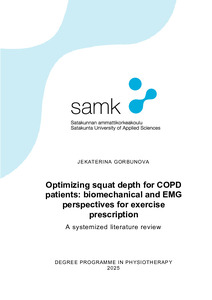Optimizing squat depth for COPD patients: biomechanical and EMG perspectives for exercise prescription : A systemized literature review
Gorbunova, Jekaterina (2025)
Gorbunova, Jekaterina
2025
All rights reserved. This publication is copyrighted. You may download, display and print it for Your own personal use. Commercial use is prohibited.
Julkaisun pysyvä osoite on
https://urn.fi/URN:NBN:fi:amk-2025102726539
https://urn.fi/URN:NBN:fi:amk-2025102726539
Tiivistelmä
The study aimed to investigate, based on existing research evidence, how squat depth affected biomechanical loading, quadriceps activation, and functional results in patients with chronic obstructive pulmonary disease (COPD). This topic was chosen because, there are no clear guidelines on how to prescribe squat depth for this patient group despite the fact that squats are one of the most popular and functionally significant exercises. The uncertainty has made it difficult for physiotherapists to find a balance between cardiorespiratory safety and muscle training.
A systematized literature review of the literature was conducted in order to assess and synthesise the results of earlier studies. Five research with a total 77 participants were included: narrative reviews, experimental biomechanics and EMG tests, and two randomised controlled trials. Results like hypertrophy, pulmonary function, functional exercise capacity, and activation of the quadriceps and posterior chain were evaluated in the review. According to the results, patients with mild-to-moderate respiratory dysfunction who performed deep squats experienced significant increases in strength, pulmonary function, and quality of life, as well as increased posterior chain activation in one RCT. For individuals with severe COPD or balance issues, parallel squats are a safer option because they activate the quadriceps strongly while causing less joint and spinal stress.
Despite encouraging results, the evidence is limited by small sample sizes, medium methodological quality, and the inclusion of research that the OCEBM hierarchy classifies as Level 5 evidence. The validity of conclusions is limited by this reliance on lower-level evidence, which also emphasises the need for more randomised controlled trials tailored to COPD. As a result, the current findings are not final clinical recommendations, but rather initial guidelines.
A systematized literature review of the literature was conducted in order to assess and synthesise the results of earlier studies. Five research with a total 77 participants were included: narrative reviews, experimental biomechanics and EMG tests, and two randomised controlled trials. Results like hypertrophy, pulmonary function, functional exercise capacity, and activation of the quadriceps and posterior chain were evaluated in the review. According to the results, patients with mild-to-moderate respiratory dysfunction who performed deep squats experienced significant increases in strength, pulmonary function, and quality of life, as well as increased posterior chain activation in one RCT. For individuals with severe COPD or balance issues, parallel squats are a safer option because they activate the quadriceps strongly while causing less joint and spinal stress.
Despite encouraging results, the evidence is limited by small sample sizes, medium methodological quality, and the inclusion of research that the OCEBM hierarchy classifies as Level 5 evidence. The validity of conclusions is limited by this reliance on lower-level evidence, which also emphasises the need for more randomised controlled trials tailored to COPD. As a result, the current findings are not final clinical recommendations, but rather initial guidelines.
